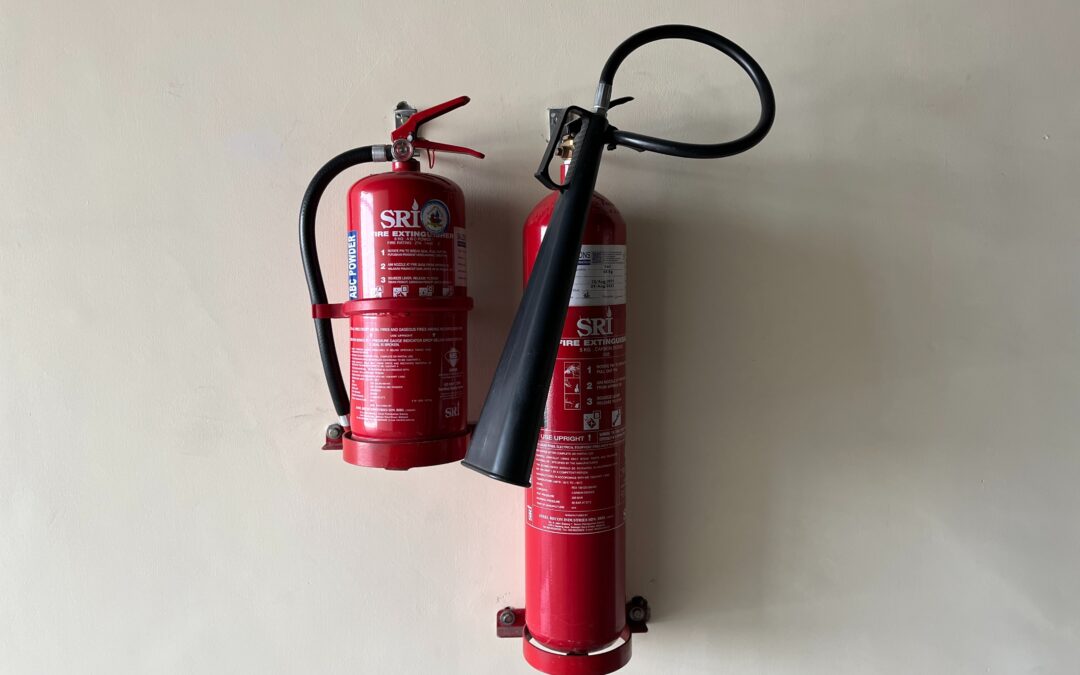Fire classes, extinguisher numerical values, and what you should know about them.
Always call 911 before attempting any fire suppression.
There are five fire classes, but these are the most common:
- Class A: Fires caused by ordinary combustibles like wood, vegetation, paper, and trash. If the end product is ash, it’s a Class A type fire. They are normally extinguished by either water or ammonium phosphate.
- Class B: Fires caused by flammable liquids or gas. Examples: oil, paints, kerosene, gasoline. This class does not include cooking oils. Class B rated extinguishers can usually suppress the typical small home cooking fire.
- Class C: Fires caused by electrically energized equipment. Examples: Downed power lines, transformers, motors, overloaded house wiring, and overloaded surge protectors. Basically, stuff that can electrocute you.
All fire extinguishers have a numerical rating associated with each of these three classes. That number translates into the amount of fire suppression the extinguisher can deliver for each class.
Example: The spec on a 10 lb. Class ABC fire extinguisher is stated as 4-A; 80-B:C.
What does that mean?
Weight: A fire extinguisher’s weight refers to the net weight of the active ingredient. It does not include the weight of the empty extinguisher tank. For example, a typica residential 10 lb. ABC fire extinguisher weighs around 19-20 lbs.
The number before the “A” indicates the equivalent amount of water the extinguisher can extinguish in multiples of 1.25 gallons. The above extinguisher rated 4-A therefore has the extinguishing capability of 1.25 times 4 gallons of water—or 5 gallons.
The number before either a “B” or “C” indicates the number of square feet of fire the extinguisher can put out. The above extinguisher rated at 80-B;C can therefore extinguish an electrical fire or, say, an oil fire, covering an 80 sq. ft. area.
What makes a good fire extinguisher?
The main criteria used in compiling this extinguisher recommended list were:
• Dependability/reliability
• Portability (which dictates an extinguisher that’s manageable and not too heavy)
• Sufficient discharge time
• Sufficient range (to allow one to use an extinguisher without being dangerously close to flames or radiant heat)
• Favorable reviews
• Good warranty
• Refillable on site (applies only to water and water mist extinguishers)
Extinguishers for Exterior Home Use
1. The 20 lb. Amerex 240 Water Fire Extinguisher.
This extinguisher will only extinguish spot Class A fires up to a total of about 2.5 sq. ft. UL rated 2A.
Fill the tank with water and pressurize it to 100 psi with air using almost any air compressor. You need not fill a water extinguisher to its maximum capacity. One can reduce the weight and maintain high pressure longer by reducing the amount of water.

Discharge time: 55 sec
Range: 45-55 ft.
2. If you instead desire an ABC dry chemical extinguisher, the Amerex A411 20 lb. ABC Dry Chemical Extinguisher is recommended:

Weight: 38 lbs.
Discharge time: 30 sec.
Range: 15-21 ft
3. If a lighter version of the Amerex A411 is needed, the 10-lb. Amerex B441 Fire Extinguisher is recommended:

Weight: 19 lbs.
Discharge time: 20 sec.
Range: 15-21 ft.
4. Space and weight permitting, a better choice and value (less than $10 more) is the Amerex B272NM – 2.5 Gallon Water Mist Fire Extinguisher:

Weight: 28 lbs.
Discharge time: 80 sec.
Range: 10-12 ft.
5. Specifically for kitchen use, one small extinguisher that stands out is the First Alert Model: Kitchen5. This inexpensive extinguisher is therefore meant to be a supplement to the water mist extinguishers.

Weight: 3 lbs.
Discharge time: Not avail.
Range: Not avail.
Fire Extinguishers for Vehicle Use
These extinguishers will be of limited use in suppressing a roadside spot Class A fire. It is recommended that your vehicle also have a collapsible shovel. Five pound extinguishers were deemed to be the appropriate size for Class A wildfire use intent, but they may have to be secured inside the vehicle or trunk due to their size. Store the Amerex extinguisher by keeping it in its compact shipping box.
5 lb. Class ABC First Alert Pro5 or the Amerex B402.
These are about equal in quality; either 5 lb. extinguisher will only extinguish about 4 sq. ft. of a Class A fire.

UL rated 3A; 40B:C
Weight: 10.2 lbs.
Discharge time: Not avail.
Range: Not avail.

UL rated 3A; 40B:C
Weight: 9.25 lbs.
Discharge time: 14 sec.
Range: 12-18 ft.
Only if a 5-lb. size cannot be accommodated, the 2.5 lb. Class ABC Amerex B417 is recommended. The B417 will only extinguish a spot Class A fire of about 1 sq. ft.

Weight: 5.5 lbs.
Discharge time: 10 sec.
Range: 9-15 ft.
Important Home Maintenance
All dry chemical extinguishers should be mixed at least several times by inversion about once every two months to avoid “caking” of the agent. Take the fire extinguisher and shake it or turn it upside down periodically so the chemicals stay mixed and don’t harden.
All dry chemical extinguishers leave a messy residue.
All the below fire extinguishers are capable of being recharged.

